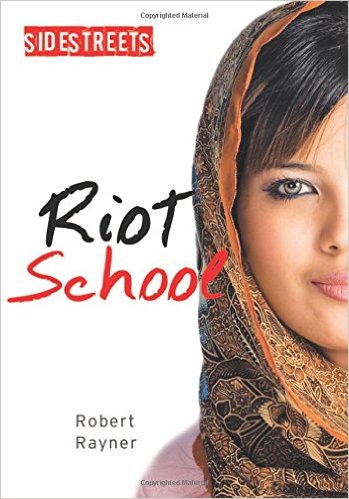| ________________
CM . . .
. Volume XXIII Number 19. . . .January 27, 2017
excerpt:
The St. Isaac’s School in Savage Harbour is closing, and all of its students will now attend the larger Laneyville Central. Though the Education Council has made the decision, they did not consult the students, and this lack of consultation causes the first protest that opens the novel. It is during this protest that the reader is introduced to Bilan Mahamoud, Arn Saunders, Grant Mograno, Lettie Snow and Barlow who will become The Group of Five, and they have no intention of giving up. Bilan is a recent Muslim immigrant whose family has fled to Canada to avoid the chaos and injustice of her home country. Arn is a black teenager who is quick to anger, and who is the extremely jealous boyfriend of Bilan. Grant is the preppy jock son of an overpowering political father. Lettie struggles with a speech impediment and the fear of speaking. She is homeless and lives inside the closed St. Isaac’s school. Barlow is known for his toughness, carries a knife and has had some run-ins with the law. At first, there is talk among them to break into the school, and steal and vandalize everything inside. However, with Bilan’s calm leadership, they decide instead to occupy the school. As the first day of school approaches, the Group of Five plan to organize a protest by trying to get a large group of students to not go on the bus to Laneyville but, instead, to occupy the now closed St. Isaac’s. However, on the first day, no one shows up except the Group of Five, and word has gotten around about their plans. Grant’s father, Mr. Morgano, calls the police, and Sgt. Hansen arrives at St. Isaac’s to see if Morgano’s suspicions are correct. Sgt. Hansen does speak with the group, but instead of arresting them for trespassing, he congratulates them and wishes them well on their quest. A few days later, Morgano and Mr. Kitchener, the superintendent, arrive with hired security guards to remove the students. This action does not end well as a brawl breaks out between the Group of Five and the guards. In the end, the Group of Five leaves the school for good. Days later, it is reported in the news that the entire school was vandalized and fires were started in piles of books. At the close of the novel, readers learn that most of the group will go to Laneyville; Lettie moved north and plans on finding empty houses to break into and live in; and Grant is attending a private school that promises to get him into more trouble than he left. The last scene is the bus leaving to Laneyville, but Bilan, Arn and Barlow watch it go as they stand in the park by St. Isaac’s. This text includes a diversity of characters that are brought together for the common purpose of protesting injustice. The novel is divided by character perspectives and, therefore, allows some latitude in the writing. The novel has notes of the film Breakfast Club though with very sharp edges. The content would be suitable for upper grades and relies on the reader to suspend disbelief as the story closes. The strongest part of Riot School is the author’s illustration of the volatile world of teenage hormones and angst. Writing to encourage student voice is admirable and necessary, and, though this novel does have its sticking points, it may interest struggling readers. Recommended with Reservations. Penta Ledger is a teacher-librarian at Gravenhurst High School in Gravenhurst, ON.
To comment
on this title or this review, send mail to cm@umanitoba.ca.
Copyright © the Manitoba Library Association. Reproduction for personal
use is permitted only if this copyright notice is maintained. Any
other reproduction is prohibited without permission.
Next Review | Table of Contents For This Issue - January 27, 2017 |
